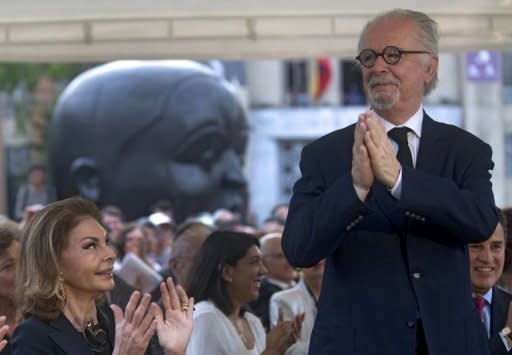Colombian artist hits 80 with no plans to retire
As he plans to celebrate his 80th birthday in his native Colombia this week, painter and sculptor Fernando Botero says the idea of retiring his paintbrush frightens him even more than death. More than 3,000 paintings and 300 sculptures are still not enough for one of the world's most famous living artists, who recently displayed his latest exhibition entitled "Viacrucis," dedicated to the Stations of the Cross of Jesus Christ. "I often think about death and it saddens me to leave this world and not be able to paint more. I love it so much," Botero told AFP in an exclusive interview from his home in Rionegro. Rionegro is not only the place he was born, but also where he started selling drawings when he was 15 years old. The upscale suburb of Medellin is surrounded by the exclusive homes of businessmen as well as former president Alvaro Uribe. The former ranch where Botero lives looks almost like a holiday resort, except he works 10-hour days on his art. And he says he could not imagine anything "more terrifying than being paralyzed by an illness." "I work more now perhaps because I know that there is so little time left," he said, smiling behind his round glasses. His studio is set up in a lush park within a lighted pavilion, away from the house in a place under surveillance of the police and a freed parrot. Botero, who is sometimes affectionately called "maestro," usually takes refuge in the green heights of the Andes during the first month of the year to "escape the European winter" with his wife, the Greek sculptress Sophia Vari. Greatly attached to the smelters of his sculpture studios in Tuscany as well as his homes in Monaco and New York, Botero says he does not plan to return permanently to Colombia, where he says he feels no "nostalgia" for the difficult start to his artistic career. "When I started, it was an 'exotic' profession in Colombia," Botero said. "It was neither accepted nor did it have any prospects." His family warned him that he would not be able to support himself through his painting. "But I did it anyway and fortunately I'm still here painting," he said. Now the school that expelled the disruptive student bears his name. Botero left Colombia 62 years ago to discover Europe and the United States. He arrived with "$200 in my pocket" in New York, where he met Malov Dietrich, director of the German Museum, who helped propel his career in the 1970s after triumphant exhibitions in Germany. "I went from being a complete unknown without even a gallery in New York to being contacted by the biggest merchants in the world," he said. His art has been displayed in exhibitions along a canal in Venice and in Paris on the Champs-Elysees and in front of the pyramids of the Louvre Museum. His artistry and sculptures are seen in voluptuous, larger-than-life figures. His style came as a revelation in 1957 in his painting "Still Life with Mandolin" when Botero accidentally drew a hole too small for the instrument, lending it what he called "a new dimension that was more voluminous, more monumental, more extravagant, more extreme." A self-proclaimed "defender of volume" in modern art, Botero says his success comes from paintings that "speak directly" to the public and do "not require explanation." He has donated part of his personal art collection to a museum in Bogota in exchange for free public access to the galleries. The total value of his artistic donations is estimated by experts at more than $200 million. He says he is "touched" by Colombians who sometimes stop him on the street to say "thank you." "It is a very great sign of affection and I think few artists in history have had the privilege of having this type of recognition," Botero said.




